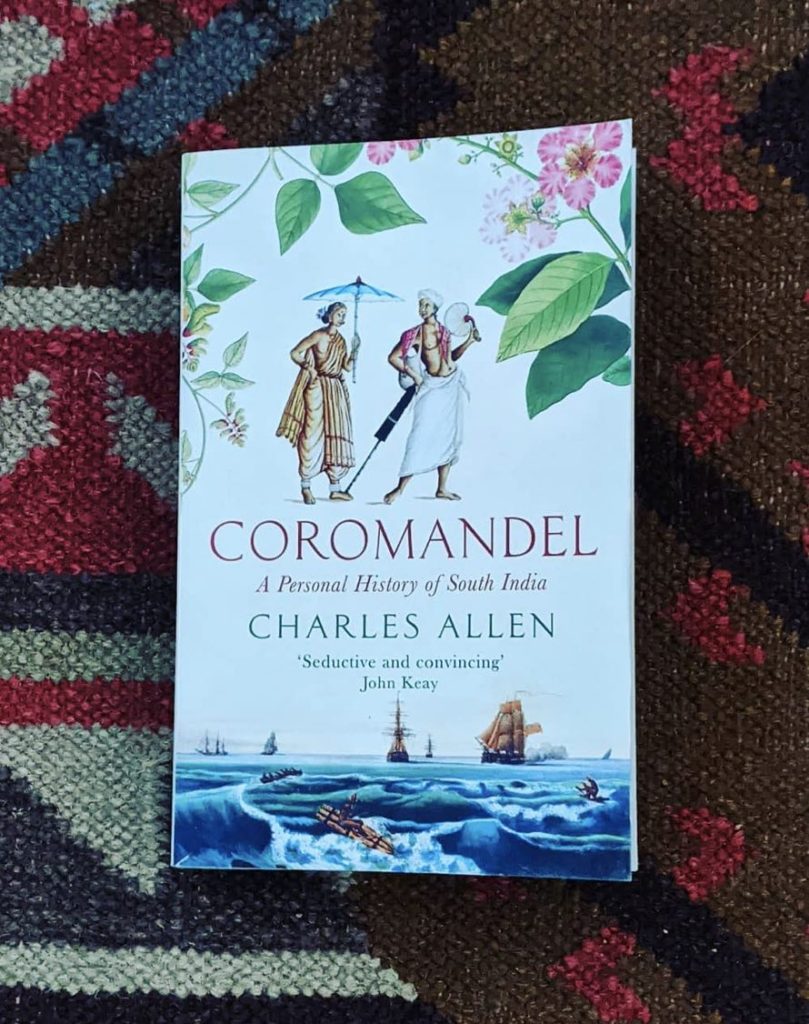Charles Allen
For once, I’d judge the book by its cover, because the multiple themes, the detailing and the overall quaint, charming imagery are a good representation of what the book will deliver. While the title of the book is an indication of its focus, it actually does more in terms of coverage, and provides a fantastic narrative of South India – historical, social, societal, cultural and political facets.
Over a period of time, history becomes stories, then legend, and finally myths. This is the journey that Charles Allen undertakes, and while he smartly calls it a “personal history” to avoid religious minefields, it is a comprehensive and erudite discussion.
He begins at the end of the subcontinent – Cape Comorin (Kanyakumari) and traces the tectonic shifts that created the Indian Plate, which we know as the Deccan, and its rock walls on one side – the Western Ghats, with Palakkad providing the only gap until the railways were built in the nineteenth century. The rest of the first chapter provides a good summary of the hunter-gatherer populations that resided in this part of the world in the Mesolithic era.
There’s then a detour – to the North and the Harappans. It also contains a clear, scientifically backed commentary of the Aryans, the location of the Saraswati and the connection to the Zoroastrians, the historical account of the Vedas, and the epics – Mahabharata and Ramayana.
We then return to “Agastya’s country”, early Tamil literature and the sage himself, who is credited with bringing Sanskrit to the South. The chapter clarifies and rebuts the paradox of him (also) being the person who brought Tamil to the South! This chapter is also interesting because it touches upon the origins of Vishnu and Shiva in mythology. The next few chapters were quite an eye opener for me, because it showed how both Jainism and Buddhism were dominant in the south, including Kerala. To the extent, where even Sabarimala, Ayyappa’s abode, has its origins in Buddhist shrine. Dharmashasta’s devotees chanting Swamiye Saranam Ayyappa seen side by side with Buddham saranam gacchami. Fascinating! It also captures the reasons behind the migration of Jains to the South, whose ranks include the first great emperor of India – Chandragupta Maurya. Speaking of empires, the Chola, Chera and Pandya dynasties were the result of a three way split between brothers who didn’t want to share power.
A following chapter throws light on one of the most under-acknowledged dynasties in India, who ruled for almost five centuries – the Satavahanas. Muziris finds a mention too, as the primary trading port for Romans. In other international voyages, we find Bodhidharma, the South Indian monk who exported Mahayana Buddhism to China – which became Chan and finally in Japan, Zen. But contrary to pop culture, Shaolin kung fu wasn’t something he introduced to China.
“Juggernaut” covers the origins of Vishnu (including the avatars) and Shiva in greater detail, and is made even more interesting by the suggestion that the lord of Puri was (again) originally a Buddhist shrine. Apparently ‘palli’ was the original term for ‘vihara’ and in Kerala, it became the common term for any non-Hindu place of worship. This section also covers Adi Shankara and his role in resurrecting Hinduism. Chapter 8 finally gets us to the title, which is appropriate from a historical perspective too – its first appearance was only in 16th century maps. That also brings us to Vasco Da Gama’s terrorism, and the slow but steady entry of European powers in the Deccan. The next chapter is a deep dive into Malabar and Kerala in general, and I learned a lot – the origin of the Nambudiris and Kerala’s caste order, the context of Vivekananda calling Kerala an asylum, and that Narayana Guru had a quarrel with Gandhi during the Vaikom satyagraha. The final chapter is named after Tipu, and it also covers the rise of Islam in the South.
The endnote is a must read, and shows how nationalist forces have been trying to reshape historical narratives for a while now. It also contains a good perspective on how the cleansing of textbooks in the early 80s and their glossing over of communal clashes actually provided ammunition to those who reverse engineer history to meet their interests.
What I really loved is the systematic deconstruction of mythology into its historic components, with an amazing amount of detail. As a person who loves both mythology and history, it was an absolute treat!I am quite miffed at myself for not having read Charles Allen earlier, but plan to rectify that for sure! If you’re interested in history, this is a book I cannot recommend enough.


Leave a Reply